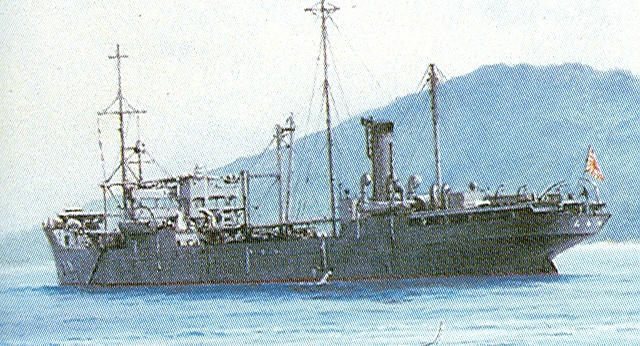YUSOSEN!

|
(Oiler by Takeshi Yuki scanned from "Color Paintings of
Japanese Warships")
IJN MUROTSU MARU:
Tabular Record of Movement
© 2008-2020 Bob Hackett and Peter Cundall.
Revision 3
20 September 1943:
Matsunoura. Laid down at Harima Zosensho K. K.ís shipyard as an 850-ton Standard Type 2TE coastal motor tanker for Chosen Yusen K.K. . [1]
9 October 1943:
Launched and named MUROTSU MARU.
29 October 1943:
Completed and registered at Jinsen, Chosen ( also known as Inchon, now Incheon, South Korea). Her gross registered (GRT) tonnage and net registered tonnage (NRT) respectively are 850 and 650-tons. Her call sign is JNNX. Registered as a specially installed transport (oil supply) otsu category in the Kure Naval District. That same day requisitioned by the IJn and conversion to a fleet oiler begins at the Harima Zosensho K.Kís. shipyard. [2] [3]
4 February 1944:
Completes conversion.
5 February 1944:
Departs Kure.
6 February 1944:
Arrives at Tokuyama Naval Fuel Depot.
8 February 1944:
Departs Tokuyama and transports fuel oil to Kobe, Owase, Yokkaichi, Kushimoto and Kure, then returns to Tokuyama.
30 March 1944:
At Kobe undergoes compass adjustment.
4 April 1944:
Scheduled westbound through Shionomisaki.
29 April 1944:
Departs unknown location H03 in convoy No. 8428. Arrives at Owase later this day.
29 ~ 30 April 1944:
Departs Owase for Yokkaichi and then Kushimoto.
22 May 1944:
At 0530 scheduled to pass westbound through Shionomisaki for Kure, Tokuyama and then Shimotsu.
29 May 1944:
Departs Shimotsu and arrives at Motoyama later that day.
31 May 1944:
Departs Motoyama.
2 June 1944:
Arrives at Maizuru.
9 June 1944:
Departs Maizuru and then travels over the next 3 months between Niigata, Ominato; Kataoka, Shimushu (now Baikovo, Ostrov Shumushu, Kurilskiye Ostrova, Russia); Otaru and Tokuyama.
25 June 1944:
Arrives at Kure.
4 July 1944:
At 1920 departs Kataoka Wan in convoy WO-405 also consisting of KOJO, SANTO, KOAN MARUs escorted by destroyer NOKAZE and kaibokan HACHIJO.
9 July 1944:
At 1920 arrives at Otaru.
10 July 1944:
Arrives at Ominato.
24 July 1944:
At 0400 departs Otaru in Ki-404 convoy also consisting of KASUGASAN, KOJO and SANTO MARUs escorted by kaibokan HACHIJO and destroyer NOKAZE.
29 July 1944:
At 2325 arrives at Kataoka Wan, Paramushiro Island.
25 August 1944:
Kure. Undergoes system repairs.
6 November 1944:
System repairs are completed. Departs Kure for Tokuyama, then transports fuel oil to Kure, Kobe and Yokkaichi.
30 November 1944:
Arrives at Kobe.
17 December 1944:
At 0400 scheduled to pass eastbound through Kiremezaki.
23 December 1944:
At 1530 scheduled to pass westbound through Esuzaki.
10 January 1945:
At 1500 scheduled to pass westbound through Esuzaki.
15 August 1945: Cessation of Hostilities:
Remains in service. Later alotted SCAJAP No. X-021.
1 November 1945:
Lt Samejima Osamu (67) is appointed Commanding Officer.
20 November 1945:
Maizuru Navy Yard. Begins repairs.
30 November 1945:
Removed form the naval list under instruction No. 301730.
1 December 1945:
Assigned as a special transport to the Maizuru demobilization bureau. Second demobilized officer Samejima Osamu is appointed Commanding Officer.
20 January 1946:
Repairs terminated. Never serves as a repatriation vessel.
5 March 1946:
Second demobilized officer Morita Sadusuke is appointed Commanding Officer.
15 August 1946:
Removed from the naval list and added again as No. 165.
20 August 1946:
Decommissioned.
21 August 1946:
Removed from the Navy List. Sold to an unknown private firm, probably a ship yard, for reconstruction.
1948:
The reconstruction is completed. [4]
1 April 1951:
Sold to Tokyo Yusen, K. K., Tokyo. Used as a coastal tanker along the Japanese coast.
October 1959:
Sold to Engan Yusosen, Tokyo.
November 1959:
Sold to Nisshin Tanker K. K., Tokyo.
1960:
Renamed NAGATO MARU No. 7.
22 November 1962:
Begins scrapping at Tsuneishi.
Authorsí Notes:
[1] The prototype of the 2TE class, the most unreliable and poorly constructed of the Japanese War Program ships. Three types of engine were used on the design, including an older hot bulb diesel type. With poor construction, the ships were plagued with frequent engine breakdowns and other problems. In contrast to the somewhat better 2E cargo design used mainly in Japanese waters, many 2TE tankers were called on to steam to the Philippines, Borneo and Singapore areas.
Ironically, the small size and very poor quality of the design actually meant a much higher survival rate than other wartime designs sent south as the ships spent much of their time laid up in ports awaiting, or undergoing, repairs. Postwar, the poor condition of the ships meant they were rebuilt, often from the mid-hull up, and as effectively new units, often enjoyed long post-war lives, longer than any other design. The last 2TE believed to be still afloat, cargo ship KAH POH (ex-NANSHIN MARU No. 25), was listed in Lloyds Register until at least 2002.
[2] NRT is a ship's cargo volume capacity expressed in "register tons", one of which equals to a volume of 100 cubic feet (2.83 m3). It is calculated by subtracting non-revenue-earning spaces i.e. spaces not available for carrying cargo, for example engine rooms, fuel tanks and crew quarters, from the ship's gross register tonnage (GRT). Net register tonnage (NRT) is not a measure of the weight of the ship or its cargo, and should not be confused with terms such as deadweight tonnage or displacement.
[3] There were two categories of Yusosen. (Ko) category with an IJN Captain as supervisor aboard and (Otsu) category without.
[4] MUROTSU MARU remains a tanker, somewhat unusual, as most such ships are rebuilt as cargo ships.
Thanks to Gilbert Casse of France and Berend van der Wal of Netherlands. Thanks also go to Gengoro S. Toda of Japan.
- Bob Hackett and Peter Cundall.
Back to the
Oilers Page





